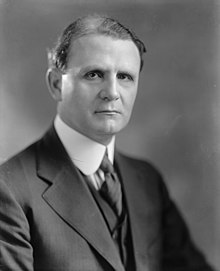Roscoe C. Patterson
Roscoe C. Patterson | |
|---|---|
 | |
| United States Senator from Missouri | |
| In office March 4, 1929 – January 3, 1935 | |
| Preceded by | James A. Reed |
| Succeeded by | Harry S. Truman |
| United States Attorney for the Western District of Missouri | |
| In office December 21, 1925 – February 28, 1929 | |
| Preceded by | Charles C. Madison |
| Succeeded by | William L. Vandeventer |
| Member of the U.S. House of Representatives from Missouri's 7th district | |
| In office March 4, 1921 – March 3, 1923 | |
| Preceded by | Samuel C. Major |
| Succeeded by | Samuel C. Major |
| Personal details | |
| Born | Roscoe Conkling Patterson September 15, 1876 Springfield, Missouri |
| Died | October 22, 1954 (aged 78) Springfield, Missouri |
| Resting place | Maple Park Cemetery, Springfield, Missouri |
| Political party | Republican |
| Spouse | Ada Holman |
| Children | 2 |
| Alma mater | Washington University in St. Louis |
| Profession | Attorney |
Roscoe Conkling Patterson (September 15, 1876 – October 22, 1954) was an American lawyer from Missouri. He was most notable for his service as a United States representative (1921–1923) and a U.S. Senator (1929–1935).
Early life
Patterson was born in Springfield, Missouri on September 15, 1876.[1] He attended public and private schools, Drury College, (Springfield) and the University of Missouri in Columbia.[1] He graduated from Washington University School of Law in St. Louis in 1897, was admitted to the bar later that year, and commenced practice in Springfield.[1]
Start of career
From 1903 to 1907, Patterson served as prosecuting attorney of Greene County.[1] In 1912, Patterson was appointed to the Missouri Republican State Committee, and he served until 1920.[1]
Patterson was elected to the United States House of Representatives in 1920 and served in the 67th Congress, March 4, 1921 to March 3, 1923.[1] He was an unsuccessful candidate for reelection in 1922 and resumed the practice of law in Springfield.[1] He was a presidential elector in 1924.[2]
From 1925 to 1929, Patterson resided in Kansas City, Missouri and was United States district attorney for the western district of Missouri.[1] He resigned in February 1929 in preparation to assume the seat in the United States Senate to which he was elected in November 1928.[1]
U.S. Senate
Patterson won the general election in November 1928.[1] He took his Senate seat the following year and served one term, March 4, 1929 to January 3, 1935.[1] While in the Senate, he was chairman of the Committee on Mines and Mining (72nd Congress).[3] His chief legislative accomplishment was sponsorship of the Lindbergh Law, which enabled federal authorities to investigate kidnappings if the victims were transported across state lines.[1]
Patterson served during the Great Depression, which was largely blamed on Republican economic policies.[1] He consistently opposed the New Deal remedies of President Franklin D. Roosevelt, which made him unpopular in Missouri.[1] As a result, Patterson was an unsuccessful candidate for reelection in the 1934 election, losing the general election to the Democratic nominee, Harry S. Truman.[1]
Later career
After leaving the Senate, Patterson resumed the practice of law in Springfield.[4] For several years, Patterson was a member of the Missouri Appellate Judicial Commission.[5]
Death and burial
Patterson suffered a stroke in July 1954.[4] His health deteriorated and he died in Springfield on October 22, 1954.[4] He was buried at Maple Park Cemetery in Springfield.[6]
Family
Patterson was married to Ada Holman of Springfield (1877–1957).[7] They were the parents of two children, Paul (1902–1924)[8] and Hadley (1908–1958).[9]
References
Sources
Books
- Barrett, Paul W.; Barrett, Mary H. (1988). Young Brothers Massacre. Columbia, MO: University of Missouri Press. ISBN 978-0-8262-0650-3.
- Christensen, Lawrence O.; Foley, William E.; Kremer, Gary, eds. (1999). Dictionary of Missouri Biography. Columbia, MO: University of Missouri Press. ISBN 978-0-8262-6016-1.
- Spencer, Thomas E. (1998). Where They're Buried. Baltimore, MD: Clearfield Company. p. 131. ISBN 978-0-8063-4823-0.
- Toberman, Walter H. (1951). Official Manual of the State of Missouri. Jefferson City, MO: Missouri Secretary of State.
- U.S. Senate Committee on Mines and Mining (1932). Hearing Record: To Create a Bituminous Coal Commission. Washington, DC: US Government Printing Office.
Newspapers
- "Funeral Service for Paul Patterson Sunday Afternoon". Springfield Republican. Springfield, MO. November 22, 1924 – via Newspapers.com.
- "GOP Leader's Widow Dead". Springfield Leader-Press. Springfield, MO. October 25, 1957 – via Newspapers.com.
- "Hadley Patterson Dies at Hospital After Long Illness". Springfield News-Leader. Springfield, MO. May 2, 1958 – via Newspapers.com.
External links
- 1876 births
- 1954 deaths
- 1924 United States presidential electors
- Politicians from Springfield, Missouri
- Washington University School of Law alumni
- University of Missouri alumni
- United States Attorneys for the Western District of Missouri
- Republican Party United States senators from Missouri
- Republican Party members of the United States House of Representatives from Missouri
- Old Right (United States)

